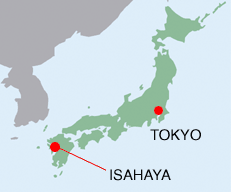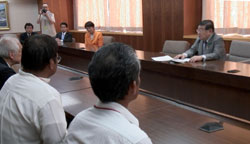[Isahaya Reclamation Project] Why it still matters 11 years after the shut-down?  The Saga District Court ordered the government to open the sluices for
five years. The Court also mentioned as unprecedented remarks and ordered
the government to recognize the relation between the shut-down of the sluices
and the environmental changes and thus the fishery damages within the Ariake
Sea. The Saga District Court ordered the government to open the sluices for
five years. The Court also mentioned as unprecedented remarks and ordered
the government to recognize the relation between the shut-down of the sluices
and the environmental changes and thus the fishery damages within the Ariake
Sea.The law suit has been made by about 2,500 fishermen from Nagasaki, Saga, Fukuoka, Kumamoto prefectures and others, appealing that the major cause of recent low fishery catches in the Ariake Sea is the shut-down of sluices at the seven kilometer sea wall which separated the Isahaya Bay from the Ariake Sea. The sea wall is the part of the National Isahaya Reclamation Project. The Court gave the government three years in order to prepare the opening sluices properly. The government has denied the relation between the project and fishery damages and claimed that opening sluices will cost huge amount of budgets. Major points of the order:
Due to insufficient data it is hard to recognize the direct relationship between the shut down of sluices and the fishery damages in the whole Ariake Sea. But people have proved such relationship does exist to some extent for fishery grounds in Isahaya Bay and nearby and criticized the government attitude. "Environmental Disputes Coordination Commission" requested the medium- and long- term surveys but the government has not conducted such investigation with sluices opened. Such incompliance could be considered as a sabotage against plaintiffs’ efforts to prove their appeal and to gather further data. Regarding public interests of the project, he added some new works can be introduced as alternative for disaster prevention, and pointed out: it is hard to say that it exceeds implementation of fishery right even if the filling up of the control lagoon by sea water due to the opening sluices causes some hardship in agricultural activities in reclaimed lands. We sincerely hope that this conclusion will bring the medium- and long- term surveys and thus appropriate measures are to be taken. The Isahaya Reclamation Project has cost approximately 250 billion yen and may have questioned the ways of conducting large-scale public works from the viewpoint of environmental concerns and cost-benefit analysis. For those who have concerns in wetland conservation especially in Asia and environmental laws. Plaintiffs requested the court for tentative measures to hold the reclamation works. The Saga District Court confirmed the fishery damage and ordered the suspension of the reclamation works in 2004. The reclamation works had suspended for nine months, but the Fukuoka High Court turned the previous court decision and reclamation works resumed and was completed in March 2008. The Court confirmed the final shut down of the seven km sea wall at the very end of Isahaya Bay in 1997 caused the slower tide current and thus environmental degradation with Isahaya, for the increase of red tides, and severe damage to gathering short-necked clams and aquaculture fishery. However, the MAFF appealed to higher court in July 2008.
Related article
|
||||||

